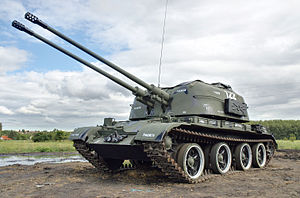ZSU-57-2
| ZSU-57-2 (Ob'yekt 500) | |
|---|---|
 |
|
| Type | Self-propelled anti-aircraft gun |
| Place of origin | Soviet Union |
| Service history | |
| In service | 1955 – early 1970s (USSR) 1957 - present (other countries) |
| Used by | See Operators |
| Wars | See Service history and Combat history |
| Production history | |
| Designer | Design Bureaus of Omsk Works No. 174 and Research Institute No. 58 in Kaliningrad, Moscow Oblast |
| Designed | 1947–1954 |
| Manufacturer | Omsk Works No. 174 |
| Produced | 1948 - 1955 (prototypes) 1957 – 1960 (serial production) |
| No. built | More than 2,023 (USSR) 250 (North Korea, old turrets on new hulls) ? (PRC, Type 80) |
| Specifications | |
| Weight | 28.1 tonnes |
| Length | 8.46 m with gun in forward position (6.22 m hull only) |
| Width | 3.27 m |
| Height | 2.71 m 2.75 m (with a tarpaulin top) |
| Crew | 6 (commander, driver, gunner, sight adjuster, and two loaders) |
|
|
|
| Armor | 8–15 mm |
|
Main
armament |
2 x 57 mm L/76.6 S-60 anti-aircraft (57 mm S-68A variant) (300 rounds) |
| Engine | V-54, 4-stroke, airless (mechanical)-injection, water-cooled 38.88 liter V12 diesel 520 hp (388 kW) at 2,000 rpm |
| Power/weight | 18.5 hp/tonne (13.81 kW/tonne) |
| Suspension | individual torsion bar with hydraulic shock absorbers on the first and last road wheels |
| Ground clearance | 425 mm |
| Fuel capacity | 830 l (including two externally mounted fuel tanks, 95 l each) |
|
Operational
range |
420 km (road) 320 km (off-road) |
| Speed | 50 km/h (31 mph) (road) 30 km/h (off-road) |
The ZSU-57-2 (Ob'yekt 500) is a Soviet self-propelled anti-aircraft gun (SPAAG), armed with two 57 mm . 'ZSU' stands for Zenitnaya Samokhodnaya Ustanovka (Russian: Зенитная Самоходная Установка), meaning "anti-aircraft self-propelled mount", '57' stands for the bore of the armament in millimetres and '2' stands for the number of gun barrels. It was the first Soviet mass-produced tracked SPAAG. In the USSR it had the unofficial nickname "Sparka", meaning "pair", referring to the twin with which the vehicle is armed.
During World War II, ground-attack aircraft emerged as a significant threat to mechanized units on the move. Conventional towed anti-aircraft artillery (AAA) was an inadequate response under such conditions owing to the time needed to bring anti-aircraft machine guns into action. This experience made it clear that an anti-aircraft tracked vehicle, armed with small-bore or heavy machine guns, was needed. Vehicles such as the German Wirbelwind and specialized variants of the US M3 Half-track had been used to good effect in the final battles of World War II, both by the US and nations which had received the M3 through Lend-Lease.
In 1942, Soviet engineers developed the T-60-3. The vehicle, based on the T-60 light tank chassis, was armed with two 12.7 mm DShK heavy machine guns; but the prototype did not go into production because of flaws in the design. The SU-72 SPAAG and several other experimental vehicles based on the T-60 or T-70 light tank chassis and armed with 37 mm autocannon were also tested in 1942–1943. The ZSU-37 was based on the chassis of the SU-76M self-propelled gun (SPG) and armed with a 37 mm 61K anti-aircraft autocannon in an open-top rotating armoured turret. The vehicle entered production in February 1945 and was in small-scale production until 1948.
...
Wikipedia
